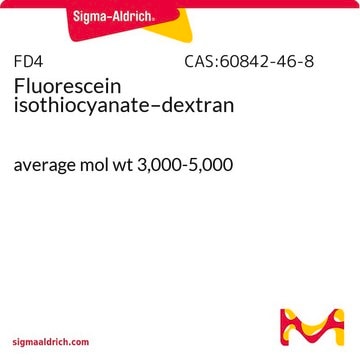All Photos(3)
About This Item
Empirical Formula (Hill Notation):
C13H9K2N5O9S2
CAS Number:
Molecular Weight:
521.57
Beilstein:
5224942
MDL number:
UNSPSC Code:
12171500
PubChem Substance ID:
NACRES:
NA.77
Recommended Products
form
powder
color
orange
fluorescence
λex 428 nm; λem 540 nm
storage temp.
room temp
SMILES string
[K+].[K+].NNC(=O)NN1C(=O)c2cc(cc3c(N)c(cc(C1=O)c23)S([O-])(=O)=O)S([O-])(=O)=O
InChI
1S/C13H11N5O9S2.2K/c14-10-5-1-4(28(22,23)24)2-6-9(5)7(3-8(10)29(25,26)27)12(20)18(11(6)19)17-13(21)16-15;;/h1-3H,14-15H2,(H2,16,17,21)(H,22,23,24)(H,25,26,27);;/q;2*+1/p-2
InChI key
HCWYSCVNSCIZCN-UHFFFAOYSA-L
Looking for similar products? Visit Product Comparison Guide
General description
Lucifer yellow CH is a fixable dye with an excitation and emission spectrum of 430 nm and 540 nm, respectively.LuciferYellow CH (LYCH) is a small, hydrophilic molecule, and highly fluorescent dye that is used for intracellular staining for the studies conducted on various types of cells. It acts as a marker for the detection of well-established tight junctions in smooth muscles, glia, and interstitial cells of Cajal (ICC).
Application
Lucifer yellow CH dipotassium salt has been used:
- to visualize cell morphology
- to assess intercellular communication activity through gap junction by scrape-loading assay
- as a component of the intracellular solution, which filled the dendrites for the visualization of neuronal morphology
- in the intracellular solution, to intracellularly label recorded neurons
Features and Benefits
Highly fluorescent dye, useful in marking nerve cells.
Storage Class Code
11 - Combustible Solids
WGK
WGK 3
Flash Point(F)
Not applicable
Flash Point(C)
Not applicable
Personal Protective Equipment
dust mask type N95 (US), Eyeshields, Gloves
Choose from one of the most recent versions:
Already Own This Product?
Find documentation for the products that you have recently purchased in the Document Library.
Customers Also Viewed
Kun-Yi Hsin et al.
Nucleic acids research, 39(Database issue), D1042-D1048 (2010-11-06)
We present the relational database EDULISS (EDinburgh University Ligand Selection System), which stores structural, physicochemical and pharmacophoric properties of small molecules. The database comprises a collection of over 4 million commercially available compounds from 28 different suppliers. A user-friendly web-based
Menachem Hanani
Journal of cellular and molecular medicine, 16(1), 22-31 (2011-07-12)
The fluorescent dye Lucifer yellow (LY) was introduced in 1978, and has been extremely useful in studying cell structure and communications. This dye has been used mostly for labelling cells by intracellular injection from microelectrodes. This review describes the numerous
A co-culture model for determining the target specificity of the de novo generated retinal ganglion cells
Teotia P, et al.
Bio-protocol, 7(7) (2017)
Gregor Belušič et al.
Proceedings. Biological sciences, 288(1961), 20211560-20211560 (2021-10-28)
In many butterflies, the ancestral trichromatic insect colour vision, based on UV-, blue- and green-sensitive photoreceptors, is extended with red-sensitive cells. Physiological evidence for red receptors has been missing in nymphalid butterflies, although some species can discriminate red hues well.
The morphology and intrinsic excitability of developing mouse retinal ganglion cells
Qu Juan and Myhr K L
PLoS ONE, 6(7), e21777-e21777 (2011)
Our team of scientists has experience in all areas of research including Life Science, Material Science, Chemical Synthesis, Chromatography, Analytical and many others.
Contact Technical Service










